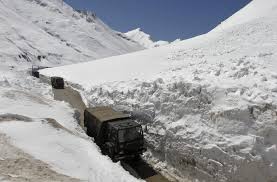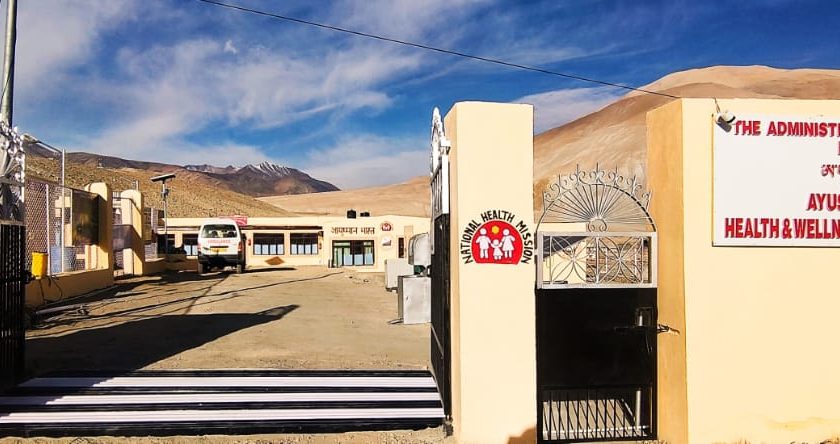Every national media house has carried recent news about the railways getting to Ladakh. The announcements read that the line would stretch to 465 kilometers and would be one of a kind, comparable only to the Qinghai-Tibet Railway Line in China. According to reports, the track would include 74 tunnels, 124 major bridges, and 396 minor bridges.
As fascinating as this development may sound, the same cannot be accepted by the people of Ladakh without a pinch of salt. To many people, these announcements are a part of the usual rhetoric and are viewed as a way to divert the attention from the Zojila tunnel, the construction of which has taken a sudden backseat as the construction company IL&FS to which the contract was given is in a financial fix.
People in Ladakh have been demanding this tunnel since time immemorial. But even though successive governments have made commitments, they never fulfill them. Defense experts have been stressing on the need to keep Ladakh accessible throughout the year, considering its strategic importance, especially in the light of the 1999 Kargil War and previous confrontations with China.
Yet, year after year, Ladakh remains cut off from the rest of the country for more than five months every winter.
When the prime minister laid the foundation stone for the construction of the tunnel in May this year, it seemed that a long pending dream was finally taking shape. But the construction of the tunnel is in a limbo once again.
Such despair has become a norm in Ladakh and the recent resignation by the sole member of parliament, Mr. Thupstan Chhewang is a true manifestation of it. The distrust of governments is a sentiment that runs deep in Ladakh.
It is well past time that the Government of India understand Ladakh for what it is – a region with many geographical and socio-economic hardships, instead of tantalizing the people with trains and tunnels.
The major issues Ladakh faces as of today can be summed in these three broad themes.
Sustenance
Ladakh depends on Jammu and Kashmir for most of the basic necessities, from vegetables and daily paraphernalia and to all kinds of basic things. Most of it comes through the Zojila pass. This makes things a lot more expensive in Ladakh, and the prices of basic commodities become astronomical as soon as winter arrives. For a common person to survive in Ladakh, especially in the winters, is a daunting task in itself – healthcare, education and access to justice become luxuries which not everyone can afford.
Education
Students seeking higher education suffer the most in Ladakh. It has become inevitable for students to go away for higher education because there is not even a single university in the Ladakh region; there are just a few government colleges which offer very limited courses.
The Kashmir region, on the other hand, has six universities as well as various other esteemed institutions such as National Institute of Technology, Srinagar. Jammu also has around six universities including big institutions such as Indian Institute of Technology, Jammu, and Indian Institute of Management, Jammu.
Moreover, the colleges that exist in Ladakh are all affiliated to the University of Kashmir and because of the lackadaisical communication of the authorities and law and order situation in Kashmir; it is the students who end up suffering. For trivial corrections in the certificates or results, students have to travel all the way to Srinagar, which is not just an ordeal but also an expensive affair. It has become common practice for a student to complete a course of three years over five years due to delays in examinations by the authorities in Kashmir. Several protests have been taken out by students across Jammu and Kashmir to demand a university in Ladakh. This was followed by a recent protest in Delhi, but no one appears to have heard their voices.
The absence of even a single decent institution in these 70 years of Independence, despite Ladakh comprising of more than 60% of the whole of Jammu and Kashmir, and having its unique socio-cultural significance, highlight the neglect Ladakh has been subjected to.
Access to administration and justice system
The state of Jammu and Kashmir has a unique system with its summer and winter capitals, which basically means that the secretariat is in Kashmir for the summer and in Jammu in winter. The high court also has two benches, one in Jammu and another in Kashmir. Ladakh, on the other hand, has no administrative or judicial headquarters.
For even the smallest of administrative issues, people have to run to Kashmir or Jammu. The same applies in the case of approaching the high court. It is almost impossible for a common person to approach the high court in winters because for that a person will have to travel to Jammu or Srinagar only via flight which would cost them Rs 20,000-25,000 one way. The flights to Srinagar and Jammu from Ladakh region in winters are as good as traveling to a foreign country. Imagine a place in India where people have to shell out Rs 20,000-30,000 for traveling to the high court or the secretariat within the state?
Tourism, an uncertain means
Ladakh has gained attention in the recent past for being a tourist destination and millions of people visit Ladakh on motorcycles and in SUVs. The growth in tourism has certainly made people earn money but at the same time, it is short lived as it the money only comes in during the summer months.
Secondly, it has overshadowed the problems that people go through on a daily basis. Last but not least, tourism has a huge environmental cost in the area, a fact which is seldom talked about.
The vision of getting trains to Ladakh is surely a fascinating one. As things stand, these announcements of trains, bridges and a hundred tunnels seem like fantasy stories that could perhaps be used to put kids to sleep during Ladakh’s long harsh winter nights.






